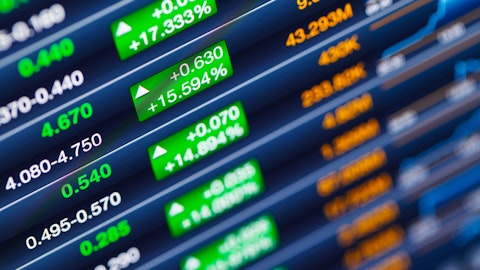4. Chesapeake Energy Corp. (NYSE:CHK)
D.E. Shaw’s Stake Value: $385M
Percentage of D.E. Shaw’s 13F Portfolio: 0.45%
Number of Hedge Fund Holdings: 67
PE Ratio (TTM): 15
Headquartered in Oklahoma City, Oklahoma, Chesapeake Energy Corp. (NYSE:CHK) is an American exploration and production company which engages in the acquisition, exploration, and development of properties, for the production of oil, natural gas, and natural gas liquids from underground reservoirs. On August 1, Benchmark analyst Subash Chandra initiated coverage of Chesapeake Energy Corp. (NYSE:CHK) with a Buy rating and a $137 price target.
Investor interest in Chesapeake Energy Corp. (NYSE:CHK) seems to have skyrocketed in the second quarter of 2022, with 67 hedge funds long the stock, compared to the preceding quarter, when 59 hedge funds were long Chesapeake Energy Corp. (NYSE:CHK). As of the second quarter of 2022, Oaktree Capital Management is the largest shareholder in the company, owning more than 10.5 million shares valued at $851.6 million. D.E. Shaw does not lag too far behind, and with a total stake of $385 million in Chesapeake Energy Corp. (NYSE:CHK), is the second largest shareholder in the company. Shaw decreased his hold over the company by 3% in Q2 2022, leading Chesapeake Energy Corp. (NYSE:CHK) to account for 0.45% of the billionaire’s 13F portfolio.
Chesapeake Energy Corp. (NYSE:CHK) was mentioned in ClearBridge Investments Q1 2022 investor letter, a copy of which can be obtained here. This is what they had to say:
“In the early days of the invasion, we made two measured changes to the portfolio based on longer-term fallout we anticipate from Russia’s invasion of Ukraine. First, we initiated small positions in U.S. natural gas producers Chesapeake (NYSE:CHK).
Given its superior environmental profile compared to other fossil fuels, we have long favored natural gas in our energy holdings. Combustion of natural gas releases 50% less CO2 than coal, 25% less CO2 than gasoline and dramatically less particulate and pollution, per the U.S. Energy Information Administration. With the advances in shale production this century, the U.S. has become a natural gas powerhouse with some of the lowest-cost and largest reserves in the world. But because natural gas is difficult to ship across the ocean (it must be liquefied, which requires expensive infrastructure on both ends of the voyage), America’s gas bounty has ironically proved a burden for U.S. producers.
The surplus of natural gas in North America has resulted in low prices and weak earnings for gas-focused producers. Exports, while growing, are restrained by the high cost of building export infrastructure. Europe, in a Faustian bargain, has relied on abundant, inexpensive Russian gas transported by pipeline.
Despite the abundance of low-cost resources and a superior environmental profile, the investment case for U.S. natural gas producers was previously unfavorable due to oversupply in the domestic market.
In the days preceding the invasion, we were quick to realize the war would change global energy flows. Europe is shifting away from Russia and toward new sources of imported liquified natural gas. We purchased our stakes in Chesapeake to capitalize on these trends. The recently announced energy pact between the U.S. and Europe represents an early positive datapoint in support of this investment thesis.”





